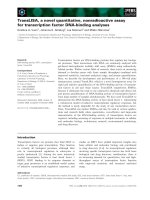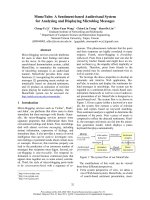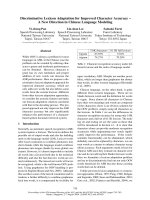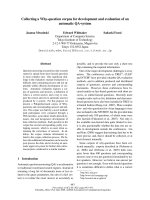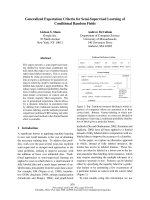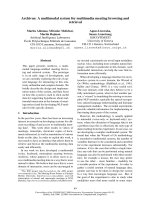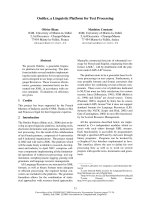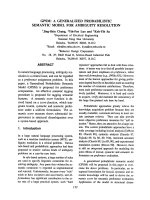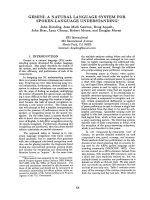Báo cáo khoa học: "Char_align:A Program for Aligning Parallel Texts at the Character Level" pdf
Bạn đang xem bản rút gọn của tài liệu. Xem và tải ngay bản đầy đủ của tài liệu tại đây (624.17 KB, 8 trang )
Char_align: A Program for Aligning Parallel Texts
at the Character Level
Kenneth Ward Church
AT&T Bell Laboratories
600 Mountain Avenue
Murray Hill NJ, 07974-0636
kwc @research.att.com
Abstract
There have been a number of recent papers on aligning parallel texts at the sentence level, e.g., Brown
et al
(1991),
Gale and Church (to appear), Isabelle (1992), Kay and R/Ssenschein (to appear), Simard
et al
(1992), Warwick-
Armstrong and Russell (1990). On clean inputs, such as the Canadian Hansards, these methods have been very
successful (at least 96% correct by sentence). Unfortunately, if the input is noisy (due to OCR and/or unknown
markup conventions), then these methods tend to break down because the noise can make it difficult to find
paragraph boundaries, let alone sentences. This paper describes a new program,
charalign,
that aligns texts at the
character level rather than at the sentence/paragraph level, based on the cognate approach proposed by Simard
et al.
1. Introduction
Parallel texts have recently received considerable
attention in machine translation (e.g., Brown
et al,
1990), bilingual lexicography (e.g., Klavans and
Tzoukermann, 1990), and terminology research for
human translators (e.g., Isabelle, 1992). We have been
most interested in the terminology application.
Translators find it extremely embarrassing when
"store" (in the computer sense) is translated as
"grocery," or when "magnetic fields" is translated as
"magnetic meadows." Terminology errors of this
kind are all too common because the translator is
generally not as familiar with the subject domain as
the author of the source text or the readers of the target
text. Parallel texts could be used to help translators
overcome their lack of domain expertise by providing
them with the ability to search previously translated
documents for examples of potentially difficult
expressions and see how they were translated in the
past.
While pursuing this possibility with a commercial
translation organization, AT&T Language Line
Services, we discovered that we needed to completely
redesign our alignment programs in order to deal more
effectively with texts supplied by AT&T Language
Line's customers in whatever format they happen to be
available in. All too often these texts are not available
in electronic form. And even if they are available in
electronic form, it may not be worth the effort to clean
them up by hand.
2. Real Texts are Noisy
Most previous work depends on being able to identify
paragraph and sentence boundaries with fairly high
reliability. We have found it so difficult to find
paragraph boundaries in texts that have been OCRed
that we have decided to abandon the paragraph/sen-
tence approach. Figure i, for example, shows some
parallel text (selected from the official record of the
European Parliament) that has been processed with the
Xerox ScanWorX OCR program. The OCR output is
remarkably good, but nevertheless, the paragraphs are
more elusive than it might appear at first.
The first problem we encountered was the missing
blank line between the second and third paragraphs in
the French (Figure lb). Although this missing line
might obscure the boundary between the two
paragraphs, one could imagine methods that could
overcome missing blank lines.
A more serious problem is illustrated by two phrases
highlighted in italics in Figure 1, "Petitions
Documents received ," and its French equivalent,
"Prtittons - Drprt de documents " When we first
read the OCR output, we found these two expressions
somewhat confusing, and didn't understand why they
ended up in such different places in the OCR output.
After inspecting the original hardcopy, we realized
that they were footnotes, and that their location in the
OCR output depends on the location of the page
breaks. Page breaks are extremely complicated. Most
alignment programs don't attempt to deal with issues
such as footnotes, headers, footers, tables, figures and
other types of floating displays.
One might believe that these layout problems could be
avoided if only we could obtain the texts in electronic
format. Perhaps so. But ironically, electronic formats
are also problematic, though for different reasons.
Figure la: An Example of OCRed English
4. Agenda
PRESIDENT. - We now come to the agenda for this
week.
SEAL (5). - Mr President, I should like to protest
most strongly against the fact that there is no debate
on topical and urgent subjects on the agenda for this
part-session. I know that this decision was taken by
the enlarged Bureau because this is an extraordinary
meeting. None the less, how can we be taken seriously
as a Parliament if we are going to consider only inter-
nal matters while the world goes on outside? I would
like to ask you to ask the enlarged Bureau to look at
how we might have extra sittings in which urgencies
would be included.
Having said that to the Chair and bearing in mind that
there are no urgencies, I should like to ask the Com-
mission to make statements on two items. First of all,
what action is the Community taking to help the peo-
ple of Nicaragua, who have suffered a most enormous
natural disaster which has left one-third of the popula-
tion homeless? Secondly, would Commissioner Suth-
erland make a statement on the situation that has aft-
sen in the United Kingdom, where the British Govern-
ment has subsidized Aerospace to the tune of UKL
1 billion by selling them the Royal Ordnance factories
at a knockdown price and allowing them to asset-strip
in order to get this kind of cash?
(Protests from the right)
Petitions Documents received - Texts of treaties for-
warded by the Council: see minutes. [italics added]
No 2-370/6 Debates of the European [ ]
PRESIDENT. - I think you have just raised about
four urgencies in one them. We cannot allow this. The
enlarged Bureau made a decision. This decision came
to this House and the House has confirmed it. This is
a special part-session. We have an enormous amount
of work to do and I suggest we get on with it.
There are a large number of different markup
languages, conventions, implementations, platforms,
etc., many of which are obscure and some of which are
proprietary. In more than one instance, we have
decided that the electronic format was more trouble
than it was worth, and have resorted to OCR. Even
when we did end up using the electronic format, much
of the markup had to be treated as noise since we
haven't been able to build interpreters to handle all of
the world's markup languages, or even a large
percentage of them.
2
Figure lb: An Example of OCRed French
4. Ordre du jour
Le Pr6sident. - Nous passons maintenant h l'or-
dre du jour de cette semaine.
Seal (s). - (EN> Monsieur le Pr6sident, je pro-
teste 6nergiquement contre le fait que l'ordm du
jour de cette session ne pr6voit pas de d6bat
d'actualit6 et d'urgence. Je sais que cette d6cision
a 6t6 prise par le Bureau 61argi parce qu'il s'agit
d'une session extraordinaire. N6anmoins, comment
pourrions-nous, en tant que Parlement, &re pris
au s6rieux si nous ne nous occupons que de nos
petits probl~mes internes sans nous soucier de ce
qui se passe dans le monde? Je vous serais recon-
naissant de bien vouloir demander au Bureau 61ar-
gi de voir comment nous pourrions avoir des
s6ances suppl6mentaims pour aborder les questions
urgentes.
Cela dit, et puisqu'il n'y a pas de probl~mes
urgents, je voudrais demander ~t la Commission de
faire des d6clarations sur deux points. Premiere-
merit: quelles actions la Communaut6 envisage-t-
elle pour venir en aide au peuple du Nicaragua,
Pdtittons - DdpSt de documents Transmission par le Conseil de
textes d'accords: CE. proc~s-verbai. [italics added]
qui vient de subir une immense catastrophe natu-
relle laissant sans abri le tiers de la population?
Deuxi~mement: le commissaire Sutherland pour-
rait-il faire une d6claration au sujet de la situation
cr66e au Royaume-Uni par la d6cision du gouver-
nement britannique d'accorder ~t la soci~t6 Aero-
space une subvention s'61evant hun milliard de
livres sterling en lui vendant les Royal Ordinance
Factories ~t un prix cadeau et en lui permettant de
brader des 616ments d'actif afin de r6unir des
liquidit6s de cet ordre?
(Protestations ~t droite>
Le Pr6sident. - Je pense que vous venez de
parler de quatre urgences en une seule. Nous ne
pouvons le permettre. Le Bureau 61argi a pris une
d6cision. Cette d6cision a 6t6 transmise ~ l'Assem-
bl6e et l'Assembl6e l'a ent6rin6e. La pr~sente p~-
riode de session est une p6riode de session sp~-
ciale. Nous avons beaucoup de pain sur la planche
et j e vous propose d'avancer.
3. Aligning at the Character
Level
Because of the noise issues, we decided to look for an
alternative to paragraph-based alignment methods.
The resulting program, charalign, works at the
character level using an approach inspired by the
cognate method proposed in Simard et al (1992).
Figures 2 show the results of char_align on a sample
of Canadian Hansard data, kindly provided by Simard
et al, along with alignments as determined by their
panel of 8 judges. Simard et al (1992) refer to this
dataset as the "bard" dataset and their other dataset as
the "easy" dataset, so-named to reflect the fact that
the former dataset was relatively more difficult than
the latter for the class of alignment methods that they
were evaluating. Figure 2 plotsf(x) as a function of x,
where x is a byte position in the English text andf(x)
is the corresponding byte position in the French text,
as determined by char_align. For comparison's sake,
the plot also shows a straight line connecting the two
endpoints of the file. Note that f(x) follows the
straight line fairly closely, though there are small but
important residuals, which may be easier to see in
Figure 3.
Figure 3 plots the residuals from the straight line. The
residuals can be computed as f(x) - cx, where c is
the ratio of the lengths of the two files (0.91). The
residuals usually have fairly small magnitudes, rarely
more than a few percent of the length of the file. In
Figure 3, for example, residuals have magnitudes less
than 2% of the length of the target file.
If the residuals are large, or if they show a sharp
discontinuity, then it is very likely that the two texts
don't match up in some way (e.g., a page/figure is
missing or misplaced). We have used the residuals in
this way to help translators catch potentially embarras-
sing errors of this kind.
Figure 4 illustrates this use of the residuals for the
European Parliamentary text presented in Figure 1.
Note that the residuals have relatively large
magnitudes, e.g., 10% of the length of the file,
'compared with the 2% magnitudes in Figure 3.
Moreover, the residuals in Figure 4 have two very
sharp discontinuities. The location of these sharp
discontinuities is an important diagnostic clue for
identifying the location of the problem. In this case,
the discontinuities were caused by the two trouble-
some footnotes discussed in section 2.
_m
,+!
II
0 50000 150000 250000
x = Position in English
File
Figure 2: char_align output on the "Hard" Dataset
It
x
o
A
x
0 50000 150000 250000
x = Position in English
File
Figure 3: rotated version of Figure 2
II
~ m
0 500 1000 1500
X = Position in English
Figure 4: Residuals for text in Figure 1
(large discontinuities correspond to footnotes)
o
II
x
r~
0 50000 150000 250000
x = Position in English File
Figure 5: Figure 3 with judges' alignments
3
0
"Hard" Dataset
-200 -100 0 100
Error (in characters)
Figure 6: histogram of errors
200
"Easy" Dataset
-200
-100 0 100
Error (in characters)
200
Figure 7: histogram of errors
Figure 5 shows the correct alignments, as determined
by Simard
et ars
panel of 8 judges (sampled at
sentence boundaries), superimposed over
char_align's
output.
Char_align's
results are so close to the
judge's alignments that it is hard to see the differences
between the two.
Char_align's
errors may be easier to
see in Figure 6, which shows a histogram of
charalign's
errors. (Errors with an absolute value
greater than 200 have been omitted; less than 1% of
the data fall into this category.) The errors (2_+46
bytes) are much smaller than the length of a sentence
(129_+84 bytes). Half of the errors are less than 18
characters.
In general, performance is slightly better on shorter
files than on longer files because
char_align
doesn't
use paragraph boundaries to break up long files into
short chunks. Figure 7 shows the errors for the
"easy" dataset (-1___57 bytes), which ironically,
happens to be somewhat harder for
char_align
because the "easy" set is 2.75 times longer than the
"hard" dataset. (As in Figure 6, errors with an
absolute value greater than 200 have been omitted;
less than 1% of the data fall into this category.)
4
4. Cognates
How does
char_align
work? The program assumes
that there will often be quite a number of words near x
that will be the same as, or nearly the same as some
word nearf(x). This is especially true for historically
related language pairs such as English and French,
which share quite a number of cognates, e.g.,
government
and
gouvernement,
though it also holds
fairly well for almost any language pair that makes use
of the Roman alphabet since there will usually be a
fair number of proper nouns (e.g., surnames, company
names, place names) and numbers (e.g., dates, times)
that will be nearly the same in the two texts. We have
found that it can even work on some texts in English
and Japanese such as the AWK manual, because many
of the technical terms (e.g.,
awk, BEGIN, END,
getline, print, pring3 are
the same in both texts. We
have also found that it can work on electronic texts in
the same markup language, but different alphabets
(e.g., English and Russian versions of 5ESS®
telephone switch manuals, formatted in troff).
Figures 8 and 9 below demonstrate the cognate
property using a scatter plot technique which we call
dotplots
(Church and Helfman, to appear). The source
text
(N x
bytes) is concatenated to the target text
(Ny
bytes) to form a single input sequence of
Nx+Ny
bytes. A dot is placed in position
i,j
whenever the
input token at position i is the same as the input token
at position j. (The origin is placed in the upper left
corner for reasons that need not concern us here.)
Various signal processing techniques are used to
compress dotplots for large
N x
+Ny.
The
implementation of dotplots are discussed in more
detail in section 7.
The dotplots in Figures 8 and 9 look very similar, with
diagonal lines superimposed over squares, though the
features are somewhat sharper in Figure 8 because the
input is much larger. Figure 8 shows a dotplot of 3
years of Canadian Hansards (37 million words) in
English and French, tokenized by words. Figure 9
shows a dotplot of a short article (25 kbytes) that
appeared in a Christian Science magazine in both
English and German, tokenized into 4-grams of
characters.
The diagonals and squares are commonly found in
dotplots of parallel text. The squares have a very
simple explanation. The upper-left quadrant and the
lower-right quadrant are darker than the other two
quadrants because the source text and the target text
are more themselves than either is like the other. This
fact, of course, is not very surprising, and is not
particularly useful for our purposes here. However,
the diagonal line running through the upper-right
quadrant is very important. This line indicates how
the two texts should be aligned.
Figure 10 shows the upper-fight quadrant of Figure 9,
enhanced by standard signal processing techniques
(e.g., low-pass filtering and thresholding). The
diagonal line in Figure 10 is almost straight, but not
quite. The minor deviations in this line are crucial for
determining the alignment of the two texts. Figures 11
and 12 make it easier to see these deviations by first
rotating the image and increasing the vertical
resolution by an order of magnitude. The alignment
program makes use of both of these transformation in
order to track the alignment path with as much
precision as possible.
"~!!.~.~.,, ?.~ :~.,.~-:. ", ~,, ~,: ;: .:~:
•: .'::
:, (~i.;~ '.! ~
J ' :.,::."-
< :',',: ;:.~ : .~," '!
',: •
~;":~"-"," '~:" ::.ii!~: .".i:;,?~'Z'~ ;. :;.:.~i~.'-~ ::~.i~;.'.!::'.:.?"
: ~,~<.: :';.<:i~;.~<:"~ ' :~ :'",P~I~':~:: i: : ,'.;,
Figure 8: A dotplot demonstrating the cognate property
(37 million words of Canadian Hansards)
[~#~._l'%~i~'~l~.lgLl~li~'/~ ¢.~.~.:"~': ~*~. '" . .! ~:" "~t,~: ~' , ~"'.:" <:7~ "-L ¢~ ."~.'5,' ':
~ ?.~.r~ ; ~.~, r. ~," , ,
,~. ~. ~:~miu~~,~: ~ '-:~.:,~, ~.w.,',.,:~
",~: ' :.~W~.' '= ~,.~
. ~' ,r~! .~:L;.~.: ;:i:~ i,~,ll~,N~l~l.~rgr~ a~._ ~.
Figure 9: A dotplot demonstrating the cognate property
(25 kbytes selected of Christian Science material)
[] lalhow
r~ lr~ ~
-o
I "I
I,
*!
°o
I -
O
@OI
%
x o_',
"!
Figure 10: Upper-right quadrant of Figure 9
(enhanced by signal processing)
5
~ xm
.°
Figure 11: Rotated version of Figure 10
current best estimate of the position in the target file
that corresponds to position x in the source file. On
subsequent iterations, the bounds are reduced as the
algorithm obtains tighter estimates on the dynamic
range of the signal. The memory that was saved by
shrinking the bounds in this way can now be used to
enhance the horizontal resolution. We keep iterating
in this fashion as long as it is possible to improve the
resolution by tightening the bounds on the signal.
while (making_progress) {
Estimate_Bounds: Bn~n, Bm~x
Estimate_Resolution_Factor : r
Compute_Dotplot
Comput e_Al ignment_Path
}
Figure 13 shows the four iterations that were required
for the Christian Science text. For expository
convenience, the last three iterations were enhanced
with a low-pass filter to make it easier to see the
signal.
• • ~,gl. •
4 1"* ' ,'i" ", •
.~,~. " ~,
Figure 12: Figure 11 with 10x gain on vertical axis
5. Bounds Estimation
It is difficult to know in advance how much dynamic
range to set aside for the vertical axis. Setting the
range too high wastes memory, and setting it too low
causes the signal to be clipped. We use an iterative
solution to find the optimal range. On the first
iteration, we set the bounds on the search space, B rain
and B rnax, very wide and see where the signal goes.
The search will consider matching any byte x in the
source file with some byte in the target file between
f(x) - Bn,an
and
f(x) + Bmax,
where
f(x)
is the
6
• . . •- #- _ .• . . _
?~ 'a * ,. ,ft.:,4. ,.,~e# p. • • ~. •., .~. -3- _~
• mr ;-;':" ".I"'",".,,. ~ ; ; ; •,4._. ~ _ ~ _'.: " .
.
• .4.o ;-:'~." 'U'~ ~"-" • "- ~:* : 4"-~ • ~" •-_'2". " .
.
Figure 13: Four iterations
6. Resolution Factor Estimation
We need to allocate an array to hold the dots. Ideally,
we would like to have enough memory so that no two
points in the search space corresponded to the same
cell in the array. That is, we would like to allocate the
dotplot array with a width of
w =N x +Ny
and a height
of
h=Bmax+Bmin.
(The array is stored in rotated
coordinates.) Unfortunately, this is generally not
possible. Therefore, we compute a "resolution"
factor, r, which indicates how much we have to
compromise from this ideal• The resolution factor, r,
which depends on the available.amount of memory M,
indicates the resolution of the dotplot array in units of
bytes per cell.
•]
(N x + Ny)
(Bma x + Brain)
r= M
The dotplot array is then allocated to have a width of
N x + Ny Bma x + Bmi n
w = and a height of h -
r r
The dots are then computed, followed by the path,
which is used to compute tighter bounds, if possible.
As can be seen in Figure 13, this iteration has a
tendency to start with a fairly square dotplot and
generate ever wider and wider dotpiots, until the signal
extends to both the top and bottom of the dotplot.
In practice, the resolution places a lower bound on the
error rate. For example, the alignments of the "easy"
and "hard" datasets mentioned above had resolutions
of 45 and 84 bytes per cell on the final iterations. It
should not be surprising that the error rates are roughly
comparable, ±46 and __.57 bytes, respectively. Increas-
ing the resolution would probably reduce the error
rate. This could be accomplished by adding memory
(M) or by splitting the input into smaller chunks (e.g.,
parsing into paragraphs).
7. Dotplot Calculation
In principle, the dotplot could be computed by simply
iterating through all pairs of positions in the two input
files, x and y, and testing whether the 4-gram of
characters in text x starting at position i are the same
as the 4-gram of characters in text y starting at
position j.
float dotplot[Nx] [Ny] ;
for(i=0; i<Nx; i++)
for(j=0; j<Ny; j++)
if(chars4(x, i) == chars4(y,
dotplot[i] [j] = i;
else dotplot[i] [j] = 0;
j))
In fact, the dotplot calculation is actually somewhat
more complicated. First, as suggested above, the
dotplot is actually stored in rotated coordinates, with a
limited resolution, r, and band limited between Bmin
and Bma x. These heuristics are necessary for space
considerations.
In addition, another set of heuristics are used to save
time. The dots are weighted to adjust for the fact that
some matches are much more interesting than others.
Matches are weighted inversely by the frequency of
the token. Thus, low frequency tokens (e.g., content
words) contribute more to the dotplot than high
frequency tokens (e.g., function words). This
weighting improves the quality of the results, but more
importantly, it makes it possible to save time by
ignoring the less important dots (e.g., those
7
corresponding to tokens with a frequency greater than
100). This heuristic is extremely important, especially
for large input files. See Church and Helfman (to
appear) for more details and fragments of c code.
8. Alignment Path Calculation
The final step is to find the best path of dots. A sub-
optimal heuristic search (with forward pruning) is used
to find the path with the largest average weight. That
is, each candidate path is scored by the sum of the
weights along the path, divided by the length of the
path, and the candidate path with the best score is
returned. Admittedly, this criterion may seem a bit ad
hoc, but it seems to work well in practice. It has the
desirable property that it favors paths with more
matches over paths with fewer matches. It also favors
shorter paths over longer paths. It might be possible to
justify the optimization criterion using a model where
the weights are interpreted as variances.
9. Conclusion
The performance of charalign is encouraging. The
error rates are often very small, usually well within the
length of a sentence or the length of a concordance
line. The program is currently being used by
translators to produce bilingual concordances for
terminology research. For this application, it is
necessary that the alignment program accept noisy
(realistic) input, e.g., raw OCR output, with little or no
manual cleanup. It is also highly desirable that the
program produce constructive diagnostics when
confronted with texts that don't align very well
because of various snafus such as missing and/or
misplaced pages. Charalign has succeeded in
meeting many of these goals because it works at the
character level and does not depend on finding
sentence and/or paragraph boundaries which are
surprisingly elusive in realistic applications.
References
Brown, P., J. Cocke, S. Della Pietra, V. Della Pietra,
F. Jelinek, J. Lafferty, R. Mercer, and P. Roossin,
(1990) "A Statistical Approach to Machine
Translation," Computational Linguistics, vol. 16, pp.
79-85.
Brown, P., Lai, J., and Mercer, R. (1991) "Aligning
Sentences in Parallel Corpora," ACL-91.
Church, K. and Helfman, J. (to appear) "Dotplot: A
Program for Exploring Self-Similarity in Millions of
Lines of Text and Code," The Journal of
Computational and Graphical Statistics, also
presented atlnterface-92.
Gale, W., and Church, K. (to appear) "A Program for
Aligning Sentences in Bilingual Corpora,"
Computational Linguistics, also presented at A CL-91.
Isabelle, P. (1992) "Bi-Textual Aids for Translators,"
in Proceedings of the Eigth Annual Conference of the
UW Centre for the New OED and Text Research,
available from the UW Centre for the New OED and
Text Research, University of Waterloo, Waterloo,
Ontario, Canada.
Kay, M. and R/Ssenschein, M. (to appear) "Text-
Translation Alignment," Computational Linguistics.
Klavans, J., and Tzoukermann, E., (1990), "The
BICORD System," COLING-90, pp 174-179.
Simard, M., Foster, G., and Isabelle, P. (1992) "Using
Cognates to Align Sentences in Bilingual Corpora,"
Fourth International Conference on Theoretical and
Methodological Issues in Machine Translation
(TMI-92), Montreal, Canada.
Warwick-Armstrong, S. and G. Russell (1990)
"Bilingual Concordancing and Bilingual Lexi-
cography," Euralex.
8
